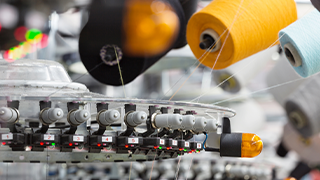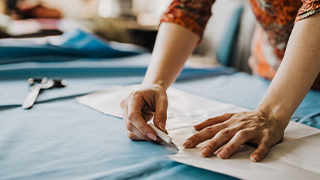Sock Dyeing & Finishing
Dyeing & Finishing Overview
The dyeing and finishing of socks is very similar to that of other apparel products. Many socks are made with dyed yarns or fiber and do not need further dyeing. Finishing processes for socks are not as varied as for other apparel products, but are still important.
Rotary Drum Machines
Rotary drum machines are commonly used in sock dye houses. These machines use low levels of water, energy, and chemicals and offer fast processing times. On-board computer systems allow for automated control of processes, including the addition of the chemistry. Modern rotary machines can also centrifugally extract the goods after wet processing.
Paddle Machines
Paddle machines consist of a revolving paddle wheel that sits in an open vessel filled with water or a processing liquor. As the wheel turns, the vanes dip down into the bath and cause the water to tumble inside. Socks are forced to move under the vanes, which causes them to tumble in the bath. These simple machines are capable of processing large poundages, are especially useful for scouring and bleaching, and are easy to load and unload. However, they are not the best choice for dyeing, because of the large amounts of water used, the energy needed to heat the water for the dyeing process, poor agitation of the socks, a longer cycle time, and their inability to extract the goods.
Extraction
Once wet processing is complete, the socks are extracted to remove excess water through centrifugal force, which minimizes drying time and energy use. Modern rotary machines have excellent extraction capabilities, which are often sufficient for drying without external extraction steps. Older rotary and paddle machines require a separate extraction in a machine designed specifically for that purpose.
Dryers
Sock dye houses use tumble dryers almost exclusively. In addition to removing water, tumble dryers tumble in bulk and relax the socks, resulting in very low shrinkage characteristics. The technology ranges from stand-alone machines to tandem operations connected to the washing and dyeing machines.
Continuous Scour & Bleach
In many modern sock dye houses, continuous tunnel ranges are used for scouring and/or bleaching. The advantages of these machines are that they are continuous in operation, require fewer operators, and can process large quantities of socks in a given production period.
Dyeing
Color can be applied to socks in fiber, yarn, or garment form. All dyestuffs used in piece-goods dyeing of various fibers can be applied to socks. Before the yarn or socks can be dyed, they must be prepared, to remove any unwanted materials. Cotton socks need to be bleached before dyeing to remove their natural off-white or cream color.
Part 1
Part 2
Finishing
“Finishing” is defined as any chemical process other than preparation or the application of color that imparts useful or desired properties to a textile or apparel product. Finishing usually occurs after the sock has been prepared and dyed, and is often the last step.
Part 1
Part 2
Boarding
After knitting and wet processing, socks normally are hot-pressed into the two-dimensional shape of a lower leg and foot, in a process called “boarding.” Various technologies are used for boarding, but all involve the use of a boarding form, steam, heat, and pressure. Boarding of cotton socks is a method of pressing for packaging and shape retention. For blends containing stretch fibers, such as spandex, or thermoplastic fibers, such as nylon or polyester, the boarding temperature can be high enough for heat setting, which will give the sock a memory for the shape in which it is boarded, reducing shrinkage.


